Multicore Fiber Bending Sensors with High Sensitivity Based on Asymmetric Excitation Scheme
Abstract
:1. Introduction
2. Experimental Setup and Working Principle
3. Theoretical Model
4. Results and Discussion
5. Conclusions
Author Contributions
Funding
Institutional Review Board Statement
Informed Consent Statement
Data Availability Statement
Acknowledgments
Conflicts of Interest
References
- Leung, C.K.Y.; Wan, K.T.; Inaudi, D.; Bao, X.; Habel, W.; Zhou, Z.; Ou, J.; Ghandehari, M.; Wu, H.C.; Imai, M. Review: Optical fifiber sensors for civil engineering applications. Mater. Struct. 2015, 48, 871–906. Available online: https://link.springer.com/article/10.1617/s11527-013-0201-7 (accessed on 10 May 2022). [CrossRef] [Green Version]
- Liehr, S.; Lenke, P.; Wendt, M.; Krebber, K.; Seeger, M.; Thiele, E.; Metschies, H.; Gebreselassie, B.; Munich, J.C. Polymer optical fiber sensors for distributed strain measurement and application in structural health monitoring. IEEE Sens. J. 2009, 9, 1330–1338. [Google Scholar] [CrossRef]
- Barrera, D.; Finazzi, V.; Villatoro, J.; Sales, S.; Pruneri, V. Packaged optical sensors based on regenerated fifiber Bragg gratings for high temperature applications. IEEE Sens. J. 2012, 12, 107–112. [Google Scholar] [CrossRef]
- Yin, Z.; Geng, Y.; Li, X.; Tan, X.; Gao, R. V-groove all-fiber core-cladding intermodal interferometer for high-temperature sensing. Appl. Opt. 2015, 54, 319–323. [Google Scholar] [CrossRef]
- Tsiminis, G.; Klari’c, T.S.; Schartner, E.P.; Warren-Smith, S.C.; Lewis, M.D.; Koblar, S.A.; Monro, T.M. Generating and measuring photochemical changes inside the brain using optical fifibers: Exploring stroke, Biomed. Opt. Express 2014, 5, 3975–3980. [Google Scholar] [CrossRef] [PubMed] [Green Version]
- Yadav, T.K.; Narayanaswamy, R.; Abu Bakar, M.H.; Kamil, Y.M.; Mahdi, M.A. Single mode tapered fiber-optic interferometer based refractive index sensor and its application to protein sensing. Opt. Express 2014, 22, 22802–22807. [Google Scholar] [CrossRef]
- Pereira, D.; Bierlich, J.; Kobelke, J.; Ferreira, M.S. Double Antiresonance Fiber Sensor for the Simultaneous Measurement of Curvature and Temperature. Sensors 2021, 21, 7778. [Google Scholar] [CrossRef]
- Yang, Z.; Yuan, W.; Yu, C. Hollow Core Bragg Fiber-Based Sensor for Simultaneous Measurement of Curvature and Temperature. Sensors 2021, 21, 7956. [Google Scholar] [CrossRef]
- Sonoda, N.; Takagi, R.; Saito, I.; Abe, T.; Zhao, S.; Tanaka, Y. Multipoint bending measurement using multicore fiber Bragg grating and two-photon absorption process in Si-APD. IEEE Sens. J. 2021, 21, 25736–25742. [Google Scholar] [CrossRef]
- Leal-Junior, A.; Theodosiou, A.; Biazi, V.; Macedo, L.; Marques, C.; Kalli, K.; Frizera, A. Temperature-insensitive curvature sensor with plane-by-plane inscription of off-center tilted Bragg grating in CYTOP fibers. IEEE Sens. J. 2022, 22, 11725–11731. [Google Scholar] [CrossRef]
- Ortega-Gomez, A.; Loyez, M.; Lobry, M.; Chah, K.; Zubia, J.; Villatoro, J.; Caucheteur, C. Plasmonoc sensors based on tilted Bragg gratings in multicore optical fibers. Opt. Express 2021, 29, 18469–18480. [Google Scholar] [CrossRef] [PubMed]
- Sharma, A.K.; Marques, C. Design and performance perspectives on fiber optic sensors with plasmonic nanostructures and gratings: A review. IEEE Sens. J. 2019, 19, 7168–7178. [Google Scholar] [CrossRef]
- Wu, H.; Ying, C.; Peng, B.; Pang, H.; Zhao, Y.; Xu, F. A fiber-optic bending curvature sensor based on thin-core fiber modal interferometer. Opt. Tech. 2012, 38, 79–82. [Google Scholar] [CrossRef]
- Flockhart, G.M.; MacPherson, W.N.; Barton, J.S.; Jones, J.D.; Zhang, L.; Bennion, I. Two-axis bend measurement with Bragg gratings in multicore optical fiber. Opt. Lett. 2003, 28, 387–389. [Google Scholar] [CrossRef] [PubMed] [Green Version]
- Butov, O.V.; Bazakutsa, A.P.; Chamorovskiy, Y.K.; Fedorov, A.N.; Shevtsov, I.A. All-Fiber Highly Sensitive Bragg Grating Bend Sensor. Sensors 2019, 19, 4228. [Google Scholar] [CrossRef] [Green Version]
- Romaniuk, R.S.; Dorosz, J.; Tekippe, V.J. Multicore Optical Fiber Components. SPIE 1987, 722, 117–124. [Google Scholar] [CrossRef]
- Shahi, S.N.; Kumar, S. A multi-core or multi-fiber WDM system. In Proceedings of the International Conference on Optical Engineering (ICOE) 2012, Belgaum, India, 26–28 July 2012. [Google Scholar] [CrossRef]
- Luís, R.S.; Rademacher, G.; Puttnam, B.J.; Eriksson, T.A.; Furukawa, H.; Ross-Adams, A.; Gross, S.; Withford, M.; Riesen, N.; Sasaki, Y.; et al. 1.2 Pb/s Throughput Transmission Using a 160 μm Cladding, 4-Core, 3-Mode Fiber. J. Lightwave Technol. 2019, 37, 1798–1804. [Google Scholar] [CrossRef]
- Hayashi, T.; Tamura, Y.; Hasegawa, T.; Taru, T. Record-low spatial mode dispersion and ultra-low loss coupled multi-core fiber for ultra-long-haul transmission. J. Lightwave Technol. 2017, 35, 450–457. [Google Scholar] [CrossRef]
- Diamantopoulos, N.P.; Shikama, K.; Nishi, H.; Fujii, T.; Kishi, T.; Takeda, K.; Abe, Y.; Matsui, T.; Kakitsuka, T.; Fukuda, H.; et al. 400-Gb/s DMT-SDM transmission based on membrane DML-array-on-silicon. J. Lightwave Technol. 2019, 37, 1805–1812. [Google Scholar] [CrossRef]
- Hayashi, T.; Tamura, Y.; Hasegawa, T.; Taru, T. 125-µm-cladding coupled multi-core fiber with ultra-low loss of 0.158 dB/km and record-low spatial mode dispersion of 6.1 ps/km1/2. In Proceedings of the OFC Conference 2016, Anaheim, CA, USA, 20–24 March 2016; Available online: https://ieeexplore.ieee.org/xpl/conhome/7518994/proceeding (accessed on 11 May 2022).
- Chen, W.; Chen, Z.; Qiu, Y.; Kong, L.; Lin, H.; Jia, C.; Chen, H.; Li, H. Highly sensitive optical fiber curvature sensor based on a seven-core fiber with a twisted structure. Appl. Opt. 2019, 58, 8776–8784. [Google Scholar] [CrossRef] [PubMed]
- Zhang, S.; Zhou, A.; Guo, H.; Zhao, Y.; Yuan, L. Highly sensitive vector curvature sensor based on a triple-core fiber interferometer. OSA Contin. 2019, 2, 1953. [Google Scholar] [CrossRef]
- Li, H.; Li, H.; Meng, F.; Lou, X.; Zhu, L. All-fiber MZI sensor based on seven-core fiber and fiber ball symmetrical structure. Opt. Lasers Eng. 2019, 112, 1–6. [Google Scholar] [CrossRef]
- Zhang, L.; Tian, Z.; Chen, N.C.; Han, H.; Liu, C.N.; Grattan, K.T.V.; Rahman, B.M.A.; Zhou, H.; Liaw, S.K.; Bai, C. Room-temperature power-stabilized narrow-linewidth tunable erbium-doped fiber ring laser based on cascaded Mach-Zehnder interferometers with different free spectral range for strain sensing. J. Lightwave Technol. 2020, 38, 1966–1974. [Google Scholar] [CrossRef]
- Yan, D.; Tian, Z.; Chen, N.K.; Zhang, L.; Yao, Y.; Xie, Y.; Shum, P.P.; Garttan, K.T.V.; Wang, D. Observation of split evanescent field distributions in tapered multicore fibers for multiline nanoparticle trapping and microsensing. Opt. Express 2021, 29, 9532–9543. [Google Scholar] [CrossRef] [PubMed]
- Liu, Y.; Dong, J.; Huang, L.; Song, X.; Li, B. Investigations on seven-core fiber based interferometric all-fiber sensor for curvature and temperature measurements. Optik 2022, 254, 168639. [Google Scholar] [CrossRef]
- Chen, N.K.; Yang, T.H.; Chen, Y.N.; Guo, T.; Guan, B.O. High sensitivity stretched-abrupt-tapered Mach-Zehnder interferometer with optical attractive force for active microsensing applications. Appl. Phys. Lett. 2013, 102, 1105–1463. [Google Scholar] [CrossRef]
- Salceda-Delgado, G.; Newkirk, A.V.; Antonio-Lopez, J.E.; Martinez-Rios, A.; Schülzgen, A.; Correa, R.A. Compact fiber-optic curvature sensor based on super-mode interference in a seven-core fiber. Opt. Lett. 2015, 40, 1468–1471. [Google Scholar] [CrossRef] [PubMed]
- Jiang, Y.; Wang, T.; Liu, C.; Feng, D.; Jiang, B.; Yang, D.; Zhao, J. Simultaneous measurement of refractive index and temperature with high sensitivity based on a multipath fiber Mach-Zehnder interferometer. Appl. Opt. 2019, 58, 4085–4090. [Google Scholar] [CrossRef]
- Villatoro, J.; Arrizabalaga, O.; Antonio-Lopez, E.; Zubia, J.; Ocariz, R.S. Multicore fiber sensors. In Proceedings of the OFC 2017, Los Angeles, CA, USA, 19–23 March 2017; Available online: https://ieeexplore.ieee.org/xpl/conhome/7932337/proceeding (accessed on 1 May 2022).
- Xia, C.; Eftekhar, M.A.; Correa, R.A.; Antonio-Lopez, J.E.; Schulzgen, A.; Christodoulides, D. Supermodes in coupled multi-core waveguide structures. IEEE J. Sel. Top. Quantum Electron. 2016, 22, 196–207. [Google Scholar] [CrossRef]
- Chao, L.; Ning, T.; Zhang, C.; Li, J.; Zhang, C.; Wen, X.; Lin, H.; Pei, L. All-fiber multipath Mach-Zehnder interferometer based on a four-core fiber for sensing applications. Sens. Actuators A Phys. 2016, 284, 148–154. [Google Scholar] [CrossRef]
- Bao, W.; Sahoo, N.; Sun, Z.; Wang, C.; Liu, S.; Wang, Y.; Zhang, L. Selective fiber Bragg grating inscription in four-core fiber for two-dimension vector bending sensing. Opt. Express 2020, 28, 26461–26469. [Google Scholar] [CrossRef] [PubMed]
- Shao, Z.; Qiao, X.; Rong, Q. Compact gas refractometer based on a tapered four-core fiber. Appl. Opt. 2018, 7, 10198–10206. [Google Scholar] [CrossRef]
- Zhang, C.; Ning, T.; Li, J.; Pei, L.; Li, C.; Lin, H. Refractive index sensor based on tapered multicore fiber. Opt. Fiber Technol. 2017, 33, 71–76. [Google Scholar] [CrossRef]
- Tagoudi, E.; Milenko, E.K.; Pissadakis, S. Intercore coupling effects in multicore optical fiber tapers using magnetic fluid out-claddings. J. Lightwave Technol. 2016, 34, 5561–5565. [Google Scholar] [CrossRef]
- Sakamoto, T.; Mori, T.; Wada, M.; Yamamoto, T.; Matsui, T.; Nakajima, K.; Yamamoto, F. Experimental and numerical evaluation of inter-core differential mode delay characteristic of weakly-coupled multi-core fiber. Opt. Express 2014, 22, 31966–31976. [Google Scholar] [CrossRef] [PubMed]
- Kokubun, Y.; Komo, T.; Takenaga, K.; Tanigawa, S.; Matsuo, S. Selective mode excitation and discrimination of four-core homogeneous coupled multi-core fiber. Opt. Express 2011, 19, B905–B914. [Google Scholar] [CrossRef]
- Macho, A.; Morant, M.; Llorente, R. Experimental evaluation of nonlinear crosstalk in multi-core fiber. Opt. Express 2015, 23, 18712–18720. [Google Scholar] [CrossRef] [PubMed]
- Barrera, D.; Gasulla, I.; Sales, S. Multipoint Two-Dimensional Curvature Optical Fiber Sensor Based on a Nontwisted Homogeneous Four-Core Fiber. J. Lightwave Technol. 2015, 33, 2445–2450. [Google Scholar] [CrossRef]
- Xia, C.; Bai, N.; Ozdur, I.; Zhou, X.; Li, G. Supermodes for optical transmission. Opt. Express 2011, 19, 16653–16664. [Google Scholar] [CrossRef] [PubMed]
- Chen, N.-K.; Feng, Z.-Z. Effect of gain-dependent phase shift for tunable abrupt-tapered Mach–Zehnder interferometers. Opt. Lett. 2010, 35, 2109–2111. [Google Scholar] [CrossRef] [PubMed]
- Govind, P. Agrawal. Optical Fibers. In Fiber-Optic Communication Systems, 4th ed.; John Wiley & Sons Inc.: Hoboken, NJ, USA, 2010; Volume 978, pp. 24–78. Available online: https://www.wiley.com/en-gb/Fiber+Optic+Communication+Systems,+4th+Edition-p-9780470505113 (accessed on 8 May 2022).
- Suo, L.; Zhou, H.; Peng, Y.-P.; Yang, F.; Chui, H.-C.; Chen, N.-K. High Sensitivity Fiber Refractive Index Sensors Based on Asymmetric Supermodes Interference in Tapered Four Core Fiber. Photonics 2022, 9, 45. [Google Scholar] [CrossRef]
- Digonnet, M.; Shaw, H.J. Wavelength multiplexing in single-mode fiber couplers. Appl. Opt. 1983, 22, 484–491. [Google Scholar] [CrossRef]
- McLandrich, M.N.; Orazi, R.J.; Marlin, H.R. Polarization independent narrow channel wavelength division multiplexing fiber couplers for 1.55 mu m. J. Lightwave Technol. 1991, 9, 442–447. [Google Scholar] [CrossRef] [Green Version]
- Chen, P.; Shu, X.; Kate, S. Compact assembly-free vector bend sensor based on all-in-fiber-core mach–zehnder interferometer. Opt. Lett. 2018, 43, 531–534. [Google Scholar] [CrossRef] [PubMed]
- Zhang, S.; Zhang, W.; Gao, S.; Geng, P.; Xue, X. Fiber-optic bending vector sensor based on mach-zehnder interferometer exploiting lateral-offset and up-taper. Opt. Lett. 2012, 37, 4480–4482. [Google Scholar] [CrossRef]
- Deng, M.; Tang, C.P.; Zhu, T.; Rao, Y.J. Highly sensitive bend sensor based on mach–zehnder interferometer using photonic crystal fiber. Opt. Commun. 2011, 284, 2849–2853. [Google Scholar] [CrossRef]
- Chen, X.; Chi, Z.; We Bb, D.J.; Kalli, K.; Peng, G.D. Highly sensitive bend sensor based on bragg grating in eccentric core polymer fiber. IEEE Photon. Technol. Lett. 2010, 22, 850–852. [Google Scholar] [CrossRef] [Green Version]
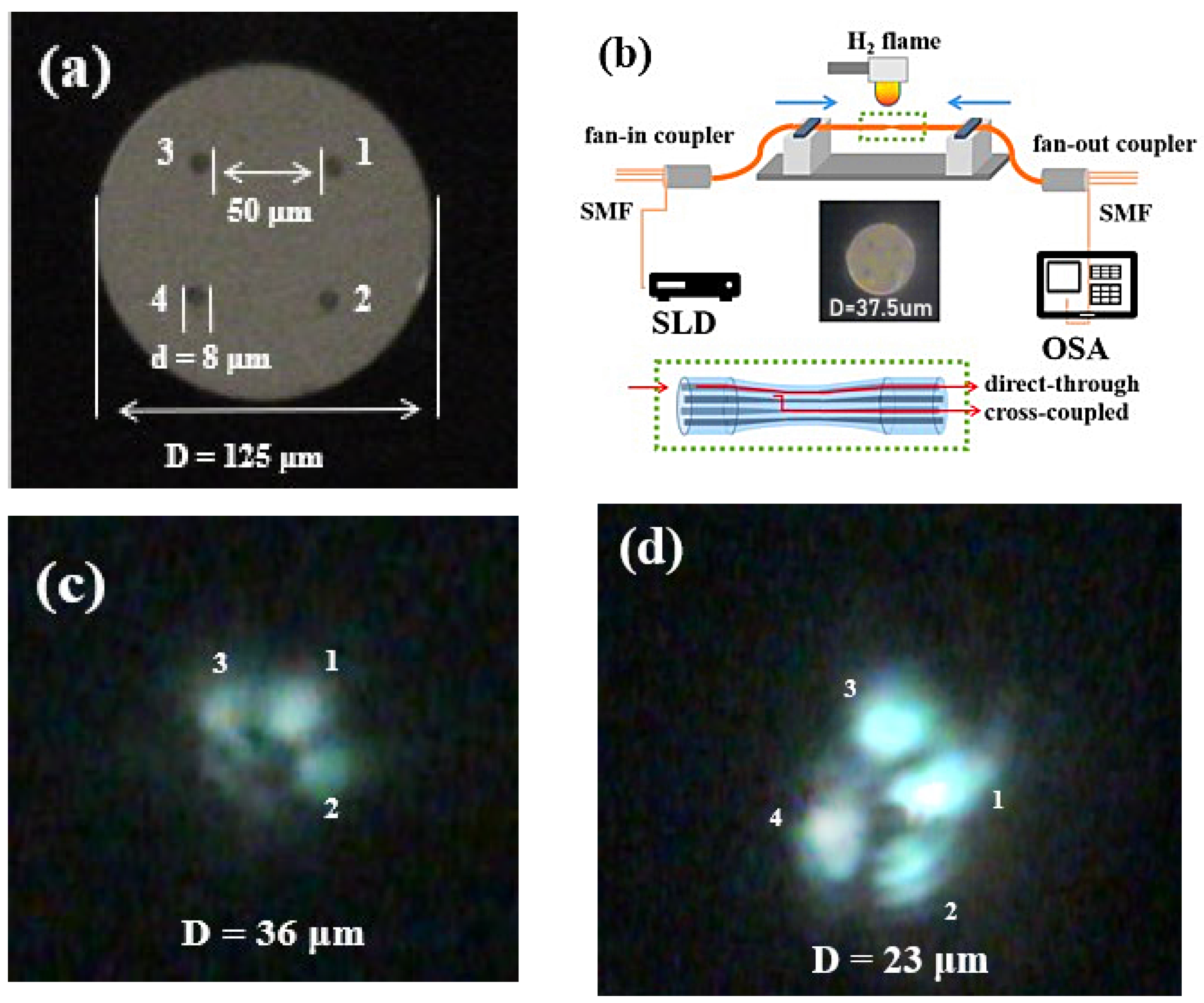
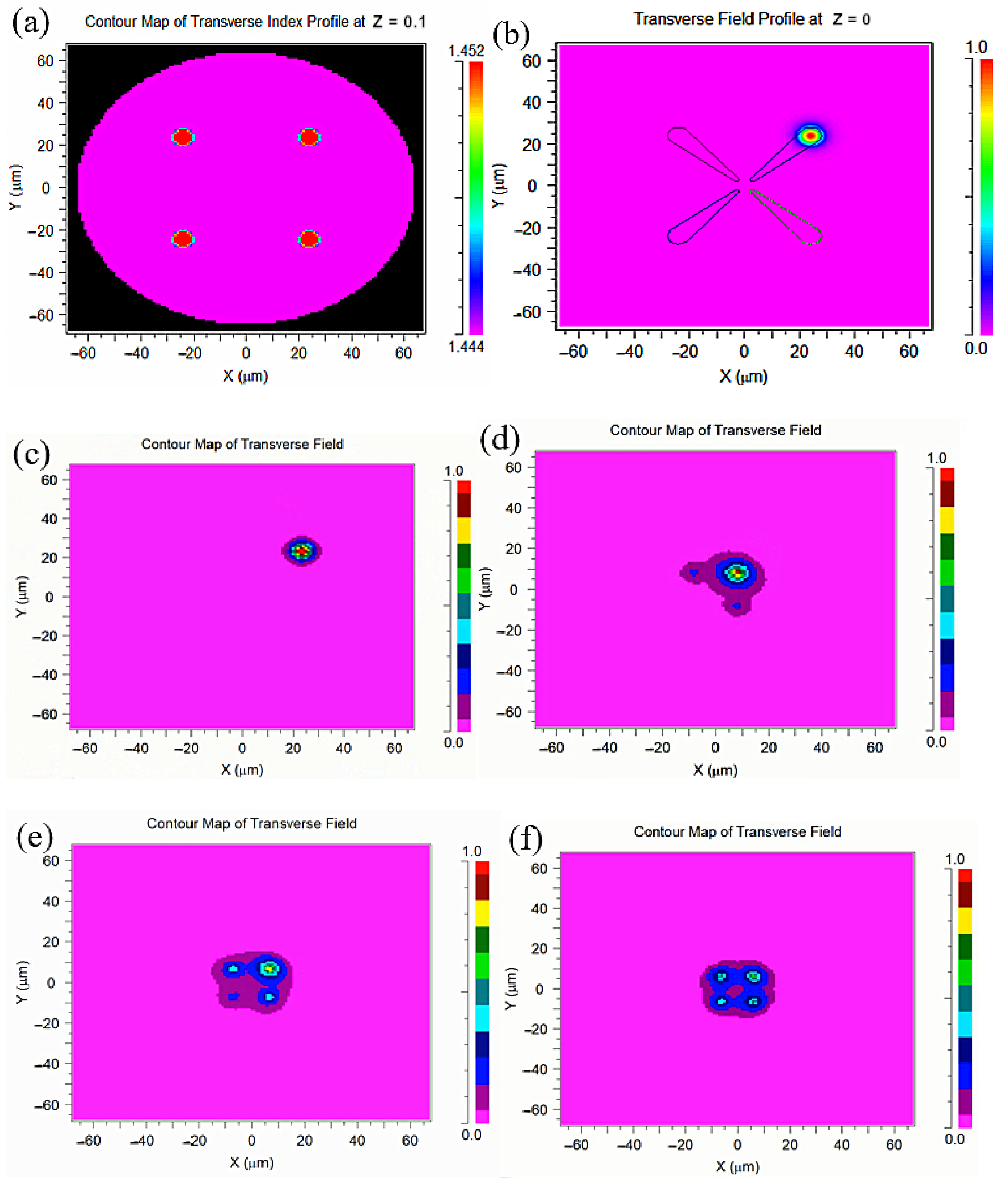
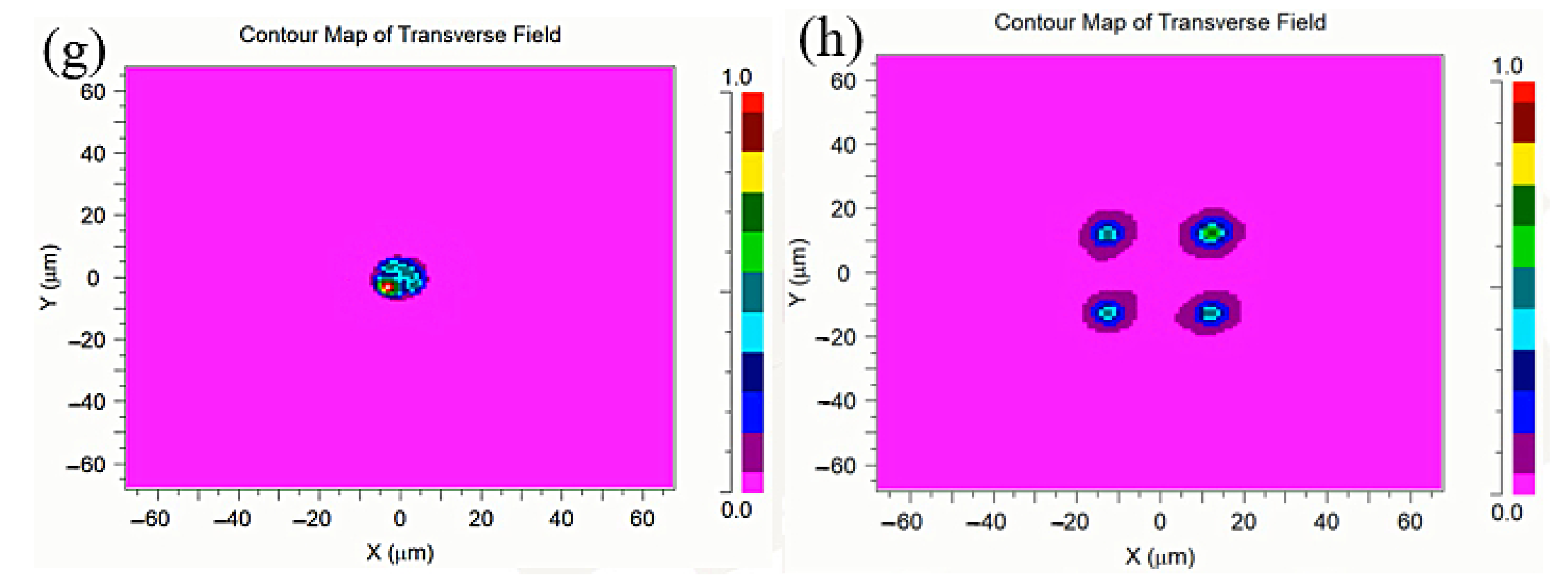


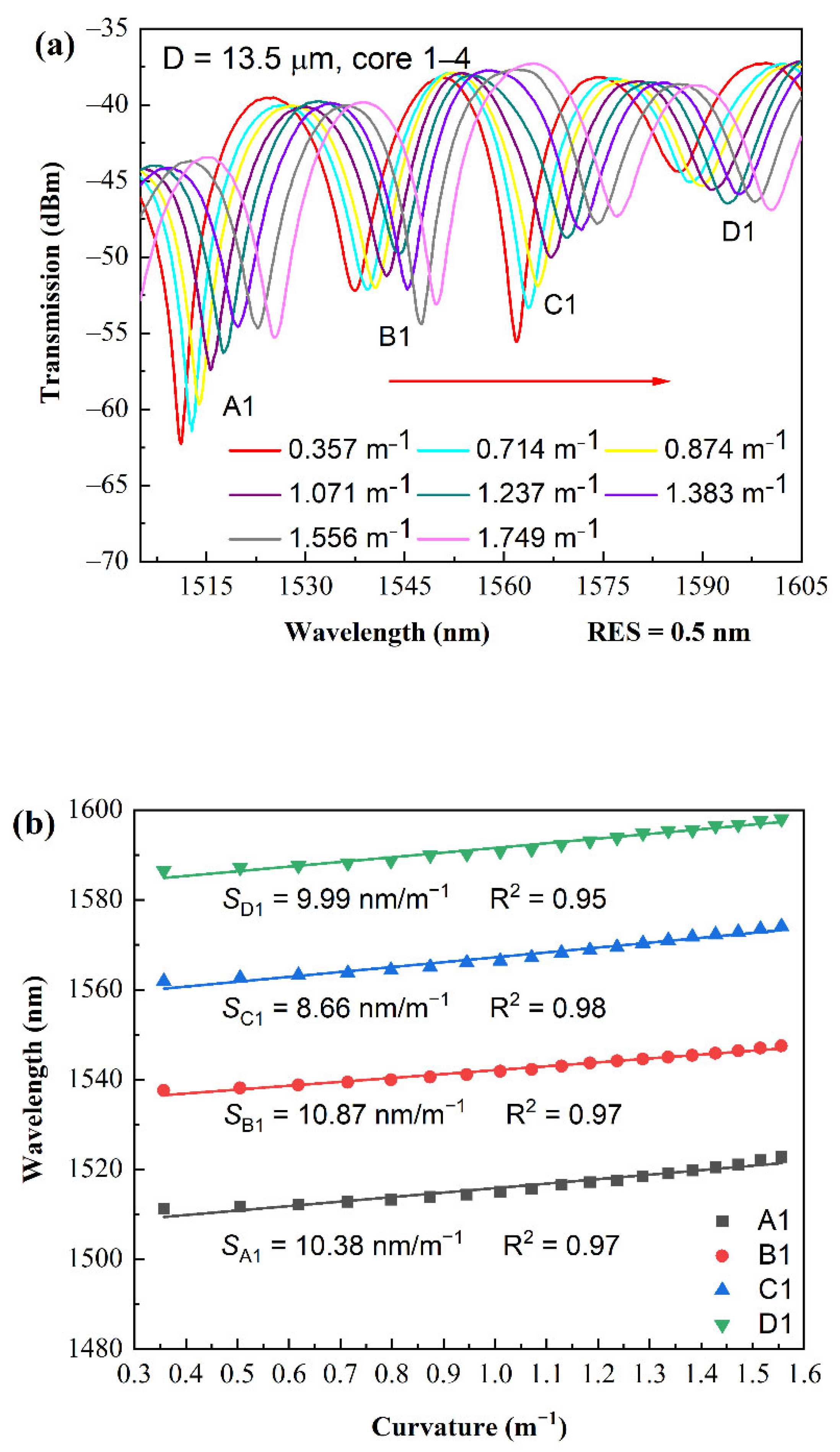
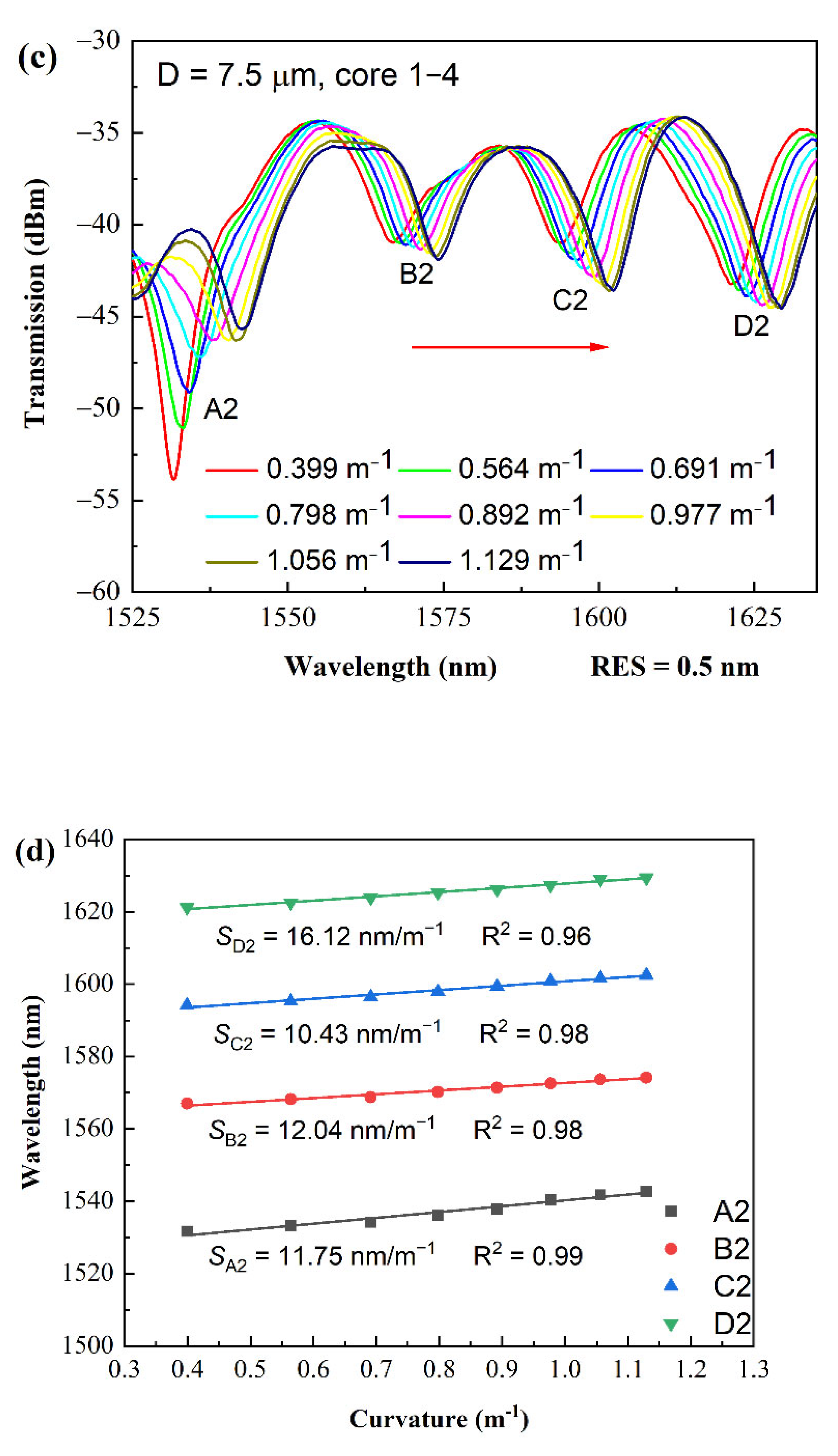
Publisher’s Note: MDPI stays neutral with regard to jurisdictional claims in published maps and institutional affiliations. |
© 2022 by the authors. Licensee MDPI, Basel, Switzerland. This article is an open access article distributed under the terms and conditions of the Creative Commons Attribution (CC BY) license (https://creativecommons.org/licenses/by/4.0/).
Share and Cite
Suo, L.; Peng, Y.-P.; Chen, N.-K. Multicore Fiber Bending Sensors with High Sensitivity Based on Asymmetric Excitation Scheme. Sensors 2022, 22, 5698. https://doi.org/10.3390/s22155698
Suo L, Peng Y-P, Chen N-K. Multicore Fiber Bending Sensors with High Sensitivity Based on Asymmetric Excitation Scheme. Sensors. 2022; 22(15):5698. https://doi.org/10.3390/s22155698
Chicago/Turabian StyleSuo, Lina, Ya-Pei Peng, and Nan-Kuang Chen. 2022. "Multicore Fiber Bending Sensors with High Sensitivity Based on Asymmetric Excitation Scheme" Sensors 22, no. 15: 5698. https://doi.org/10.3390/s22155698
APA StyleSuo, L., Peng, Y.-P., & Chen, N.-K. (2022). Multicore Fiber Bending Sensors with High Sensitivity Based on Asymmetric Excitation Scheme. Sensors, 22(15), 5698. https://doi.org/10.3390/s22155698





